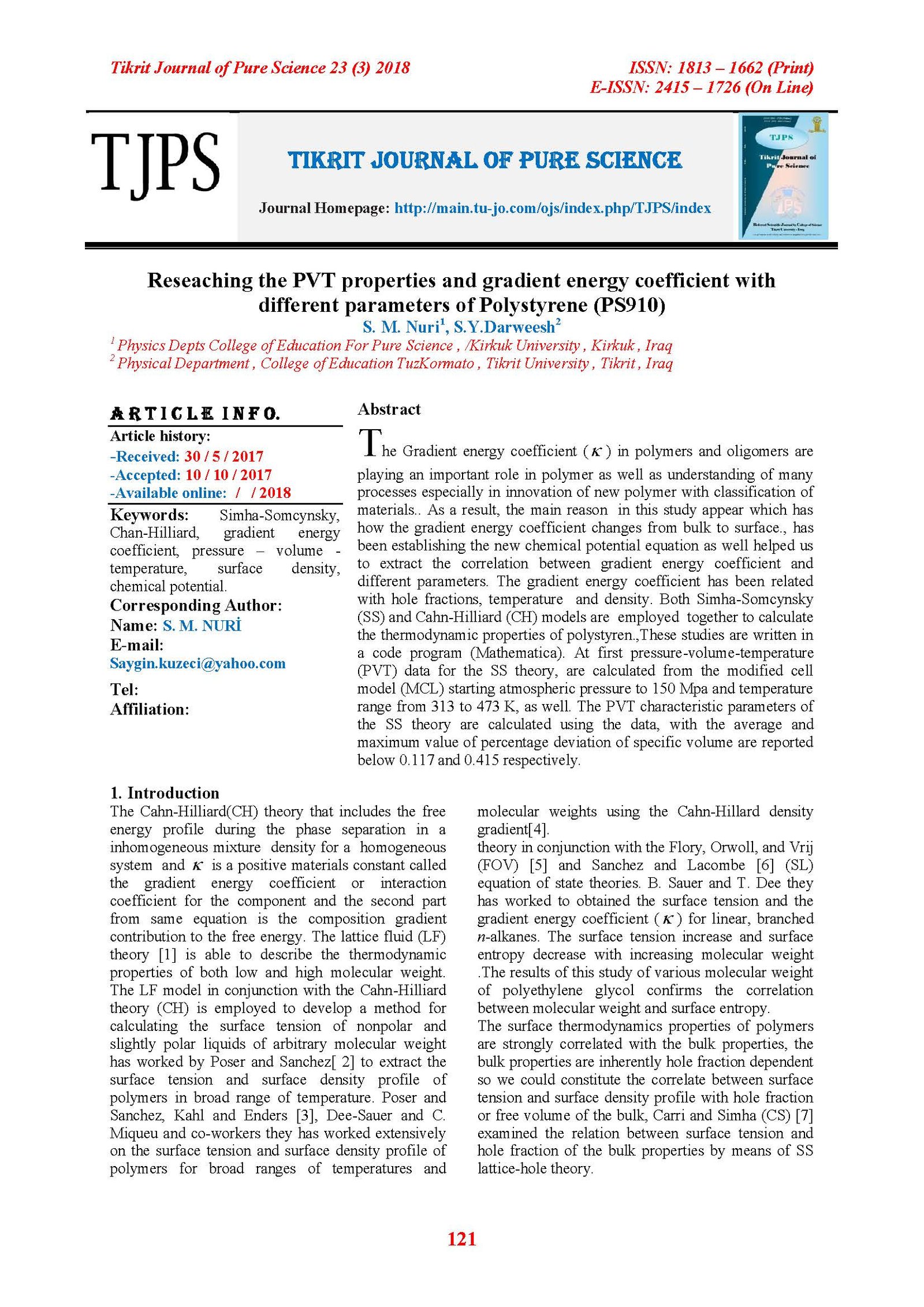Reseaching the PVT properties and gradient energy coefficient with different parameters of Polystyrene (PS910)
Main Article Content
Abstract
The Gradient energy coefficient ( ) in polymers and oligomers are playing an important role in polymer as well as understanding of many processes especially in innovation of new polymer with classification of materials.. As a result, the main reason in this study appear which has how the gradient energy coefficient changes from bulk to surface., has been establishing the new chemical potential equation as well helped us to extract the correlation between gradient energy coefficient and different parameters. The gradient energy coefficient has been related with hole fractions, temperature and density. Both Simha-Somcynsky (SS) and Cahn-Hilliard (CH) models are employed together to calculate the thermodynamic properties of polystyren.,These studies are written in a code program (Mathematica). At first pressure-volume-temperature (PVT) data for the SS theory, are calculated from the modified cell model (MCL) starting atmospheric pressure to 150 Mpa and temperature range from 313 to 473 K, as well. The PVT characteristic parameters of the SS theory are calculated using the data, with the average and maximum value of percentage deviation of specific volume are reported below 0.117 and 0.415 respectively.
Article Details

This work is licensed under a Creative Commons Attribution 4.0 International License.
Tikrit Journal of Pure Science is licensed under the Creative Commons Attribution 4.0 International License, which allows users to copy, create extracts, abstracts, and new works from the article, alter and revise the article, and make commercial use of the article (including reuse and/or resale of the article by commercial entities), provided the user gives appropriate credit (with a link to the formal publication through the relevant DOI), provides a link to the license, indicates if changes were made, and the licensor is not represented as endorsing the use made of the work. The authors hold the copyright for their published work on the Tikrit J. Pure Sci. website, while Tikrit J. Pure Sci. is responsible for appreciate citation of their work, which is released under CC-BY-4.0, enabling the unrestricted use, distribution, and reproduction of an article in any medium, provided that the original work is properly cited.
References
[1] Freed, K.F.; Dudowicz, J.: "Pragmatic analysis for the range of validity of the lattice cluster theory", Journal of Chemical Physics, 110(2) 1307-1312(1999).
[2] Poser, C,I., and Sanchez ,I. C., J. Colliod interface Sci. 69,539 (1989).
[3] Poser and Sanchez, 1981; Harrison et al., Kahl and Enders (1999).
[4] Sauer BB, Dee GT ,.. Phys., 95, 6749, Miqueu C, Mendiboure B, Graciaa C, Lachaise J, J. Modeling of the surface (1991).
[5] John Wiley & Sons, Inc.,Hoboken, New Jersey in Canada, “Handbook of Introduction to Physical Polymer Science” L.H.Sperling.-4th ed QD381. S635 USA (2006).
[6] Carri, G. A., and Simha, R., J. Colloid Interface Sci. 178,483-494(1996).
[7] Utraki, L.A; Simha, R. Macromol. Chem. Phys., Mol.Theory Simol, 10, 17, (2001).
[8] Aslan, M.,Ph.D. thesis.; Yahsi, U.: Dallanmış ve Dendrimer Makromoleküler Yapıların İstatistiki Termodinamiği in Fizik. Marmara Üniversitesi: İstanbul. P.17-27.(2009).
[9] John Wiley & Sons, Inc.,Hoboken, New Jersey in Canada, “Handbook of Introduction to Physical Polymer Science” L.H.Sperling.-4th ed QD381.S635 USA (2006).
[10] Cahn,J. W., and Hilliard, J. E., J. Chem. Phys. 28, 258-267 (1958).
[11] Sauer, B. B., and Dee, G. T., Macromolecules 24 2124 (1991).
[12] Utraki, L.A; Simha, R. Macromol. Chem. Phys., Mol.Theory Simol, 10, 17.( 2001)
[13] Jain, R. K., and Simha, R., J. Colloid and İnterface Sci. 216, 424-428 (1999).
[14] Algers J, Sperr P, Egger W, Ko¨ gel G, Maurer FHJ.Physical Review; B 67(12)125404( 2003).
